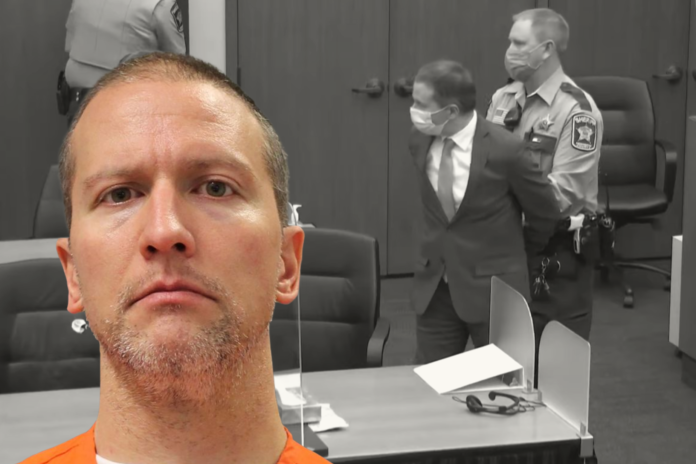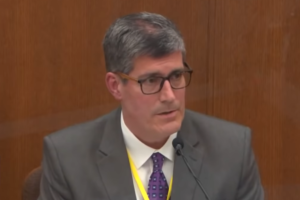
Greg Pulles | Tim Kelly
The prosecution in the Derek Chauvin case was required to prove beyond a reasonable doubt that George Floyd died due to unreasonable police restraint applied by the defendant. The prosecution had two key witnesses on the cause of death: a pulmonologist, Dr. Martin Tobin, and the Hennepin County medical examiner, Dr. Andrew Baker.
Dr. Tobin testified that lack of oxygen — asphyxiation — was the cause of death; Dr. Baker concluded that Floyd died due a cardiopulmonary arrest caused by the police subdual, restraint and neck compression.
The Chauvin trial was unique: the core issue in the case was cause of death, and the prosecution presented two medical experts who testified to two inconsistent theories of causation. In other words, if a juror accepted one theory, then the juror must have rejected the other theory. This oddity created a risk that the jury verdict could have, for example, included six guilty votes that accepted one witness’s theory and six that accepted the other witness’s theory. That is neither due process nor a unanimous jury.
The criminal trial of a police officer for harming or killing a member of the public has happened many times, too many. Often causation is not in question, like when an officer shoots someone.
But in cases where causation is at issue, the prosecution generally calls a medical examiner who explains to the jury how the conduct of the officer caused harm or death to the victim.
Contradictory theories
It is exceptional that the prosecution did not trust the testimony of the medical examiner alone as to causation and instead tried to bolster its causation case by presenting a second physician with a second theory. The unique aspect, however, is that the two theories are so at odds that if one accepts the medical examiner, one must reject the other opinion, and vice versa.
Dr. Tobin rejected the heart-failure theory and Dr. Baker emphatically rejected the asphyxiation theory. This gives us insight as to why the prosecution presented Tobin —unless it presented a medical expert who could testify that Chauvin caused the death of Floyd by cutting off his airway and inhibiting his breathing, there was a chance the case would never get to the jury.

Remember that the entire case was based on the notion that Chauvin kept Floyd in the prone position with his knee on Floyd’s neck for too long — not that he was wrong to use the prone position and his knee to restrain Floyd in the first place.
The criminal complaint states that, after a time, “force was no longer necessary to control him,” noting that Chauvin kept his knee on Floyd for two minutes and 53 seconds after Floyd became unresponsive, and finally that “Chauvin’s restraint of Floyd in this manner for a prolonged period of time was a substantial causal factor in Floyd losing consciousness.”
While an officer is justified in using the prone position to get a resister to stop resisting, he is not justified in using it to strangle the resister. This theory is best supported by Dr. Tobin’s position that Floyd died from asphyxiation, not Dr. Baker’s position that he died from cardiopulmonary arrest.
Dr. Baker, who conducted the autopsy and is responsible under Minnesota law for determining the official cause and manner of death, was steadfast in his opinion that Floyd’s severely diseased heart was “tipped over” by the altercation with police, causing a cardiopulmonary arrest. Dr. Tobin, on the other hand, testified that Floyd died from asphyxia, lack of oxygen, and that his underlying heart disease had nothing whatsoever to do with his death. Dr. Baker, however, found no evidence of asphyxia.
Dr. Tobin testified before Dr. Baker. He determined that four factors led to the low level of oxygen that he found asphyxiated Floyd.
The first factor was handcuffs and the street: both officers Chauvin and Alexander Kueng pushed Floyd’s handcuffed hands high into his back, which, together with the hard street below him, inhibited his diaphragm and the movement of his chest. This prevented him from getting oxygen into the lower part of his lungs, where oxygen gets to the blood and carbon dioxide is removed.
The second factor was Chauvin’s right knee on/across the neck, which compressed the hypopharynx, the passageway above the Adam’s apple, reducing the airflow through it by 85%.
The third factor was Floyd’s prone position, which reduced his lung-oxygen volumes by 24%.
The fourth and final factor was Chauvin’s left knee on Floyd’s back combined with Floyd’s arms being pushed up his back. This reduced the oxygen level an additional 19%. The reduction in lung-oxygen volumes also impacted the size of the opening of the hypopharynx, which shrinks as volume reduces.
Five minutes and three seconds after officer Chauvin applied his knee, Floyd died from a lack of oxygen caused by a combination of these four factors, as evidenced, Dr. Tobin testified, by his leg involuntarily jerking upwards — an anoxic seizure caused by the absence of oxygen getting to his brain.
Dr. Tobin testified that Floyd’s heart disease, high blood pressure, enlarged heart and fentanyl intoxication played no part in his death because just before Floyd was deprived of all oxygen, his breathing, measured by Dr. Tobin from watching the video, was “normal.” A perfectly healthy person subjected to the same police restraint would have died just as Mr. Floyd died.
Dr. Baker’s testimony, one day later in the trial, was that the stress of Floyd’s interaction with the police, combined with his underlying heart condition, “tipped him over the edge,” leading to cardiopulmonary arrest. Again, he found no evidence of asphyxia.

He described Floyd’s heart disease in his autopsy: “severe stenosis,” “multifocal arteriosclerotic.” His cardiovascular arteries were narrowed by 75%, and one was 90% occluded. Dr. Baker said that narrowing of 75% or greater is capable of causing sudden death. Dr. Baker also pointed to Floyd’s history of hypertension, which led to an enlarged (overweight) heart. Floyd’s heart was “way out on the bell curve,” since the upper end of normal is 510 grams based on height, and 521 grams based on weight. Floyd’s heart weighed 540 grams.
Dr. Baker was emphatic in his conclusion: Floyd had a severe underlying heart condition, he was hypertensive, his heart needed more oxygen than the average heart because of its size, and it was limited in its ability to deal with the altercation with police and the physical restriction on the ground. Stress hormones and adrenaline asked his heart to beat faster to get through the event. This was more than his heart could handle by virtue of its condition. Dr. Baker found no evidence of asphyxia.
Problems with both theories
The prosecution gave the jury two possible explanations for Floyd’s death: asphyxia and heart failure. There are serious problems with both explanations. Dr. Tobin’s testimony was always delivered with absolute certainty, which made it inherently suspect — in real life, very few things are absolutely, 100% certain. Dr. Tobin claimed that he could tell someone absolutely everything about a person’s condition, including the precise point of death, just from looking at his facial expression (he had done this “millions of times”).
And it is difficult to accept his unequivocal assertion that the potentially lethal dose of fentanyl in Floyd’s system, his severely diseased heart that was significantly on the far side of the bell curve of weight, and his high blood pressure, all combined, had no bearing on his death whatsoever. Tobin’s finding that Floyd’s heart and the drugs in his system had no impact on his breathing, based on his count of 22 breaths per minute from the video, a “normal” number, is also doubtful.
First, it is by no means easy to count Floyd’s breaths from the video (we counted a different number than the doctor did), and Floyd’s breathing seemed anything but normal. To the contrary, it seemed highly irregular and at points almost imperceptible. Moreover, if, as the doctor acknowledged, fentanyl slows down one’s breathing and a bad heart makes one breathe faster, isn’t it possible that the combination of the two canceled each other out to get to the “normal” number of breaths per minute that Tobin calculated?
Dr. Baker was a far more believable witness, but his testimony also raised serious questions. Dr. Baker acknowledged that the drugs and heart condition “played a role.” It certainly seemed from all the videos that Floyd was already having a medical event before officer Chauvin arrived, and perhaps even before any of the officers arrived.

He had been consuming illegal drugs and was obviously under the influence (the death certificate notes “fentanyl intoxication” as a contributing factor). He was foaming at the mouth, and multiple times before Chauvin’s restraint said he couldn’t breathe. He would not comply, talked irrationally, and could not get into or stay in the squad car. Dr. Baker said the police interaction “tipped” Floyd’s heart “over the edge.” Isn’t it possible that the “tipping” happened during the first 10 minutes, and not when Chauvin’s knee entered the picture? Would Floyd have died even without that last restraint?
Let’s look at drugs. Dr. Tobin dismissed any possibility of the impact of fentanyl. Fentanyl would slow down Floyd’s breathing. Just before he died, Floyd’s breathing rate of 22 breaths per minute was perfectly normal. How could this be? The prosecution took the position that Floyd had built up a huge tolerance. Leaving aside the accuracy of the doctor’s counting of breaths, Dr. Tobin would have us believe that a fentanyl level that Dr. Baker found to be over three times the potential lethal dose had no impact on Floyd’s breathing function.
Dr. Baker, on the other hand, found the presence of both fentanyl and methamphetamine to be “other contributing factors” in Floyd’s death. He explained that these played a role in Floyd’s death, but were not the direct cause. Dr. Baker had told investigators that the level of fentanyl in Floyd’s system was so high that if he had been found home alone, and there were no other apparent causes, it would have been acceptable to call his death an overdose. Dr. Baker has certified cases as overdose deaths where the level of fentanyl was 3ng/ml, while Floyd’s was 11.
What about the combination of drugs and Floyd’s heart disease? Dr. Tobin categorically ruled out any impact of Floyd’s occluded arteries and hypertension: a person with a diseased heart that is impacting his oxygen intake will have rapid breathing, and we can see from the video, said Dr. Tobin, that his breathing rate was normal.
Dr. Baker listed Floyd’s underlying medical condition as a significant factor (“other contributing conditions”) but not the direct cause of Floyd’s death. The police arrest caused Floyd’s heart to fail; it was too much for him to handle.
We wish we could ask some questions of Dr. Baker: the drugs played a role in exacerbating Floyd’s medical condition, but how do you measure how much of a role? How do you make the determination that they were not a “real” cause?
In investigator interviews, Dr. Baker was in fact leaning, at one point, to this being a “multi-factor” death, with one of the factors being “stimulants causing the heart to work faster.” Dr. Baker obviously felt there was at least a partial cause and effect between the fentanyl and the heart event. How did the doctor quantify this impact, and conclude that it was not a factor of equal impact to the police restraint? And given that the altercation with the police began well before Floyd was placed on the ground, and that he was foaming at the mouth and saying he couldn’t breathe before the prone restraint, isn’t it possible or even likely that his heart was on a fatal path to failure before that restraint? That without the restraint and neck compression the event was still too much for his heart to handle?
Here the two key witnesses directly contradicted each other on the key issue in the case, calling into question their credibility and thus all of their findings. When we set to one side the opinions of these two key prosecution witnesses, demonstrated to be fallible by the very testimony elicited by the prosecution from their medical counterpart, there are so many things to this story that just don’t add up.
A level of fentanyl over three times a potential lethal dose must have had an impact. Tolerance cannot mean that there wasn’t an impact or Floyd wouldn’t have taken the drugs. The meth he took, “small” though it was, could only have made it worse. Common sense tells you that severe heart disease and hypertension also had an impact. A man who had just been taking drugs, who is foaming at the mouth and saying that he cannot breathe before the prone restraint, and who is acting and talking irrationally and unable to get into and stay in a police car, must have been in the middle of some medical event before the police entered the picture.
At the end of the day, this anomalous case is worrisome not only because both medical opinions are suspicious, but also because the two medical opinions as to causation are mutually exclusive — each physician essentially said the other one’s opinion was incorrect. Perhaps more importantly, the key factual basis for one doctor’s view was seen by the other as insignificant. And neither opinion really embraced the causation allegation in the complaint against Chauvin — that the last three minutes of his restraint of Floyd caused Floyd’s death. Now the courts must address these serious problems in this unique case.
Greg Pulles is a lifelong Minnesotan and retired attorney who practiced in Minnesota for over 40 years.
Tim Kelly is a trial lawyer who practiced in the Twin Cities for over 40 years.
















